3. Hardware Overview
External Features
The Song Meter Micro 2 recorder is designed for long-term, outdoor deployment. Made from durable polycarbonate plastic, it is UV-resistant and weatherproof. The enclosure meets IP67 standards, meaning it can withstand temporary submersion in water up to a depth of one meter without water intrusion.
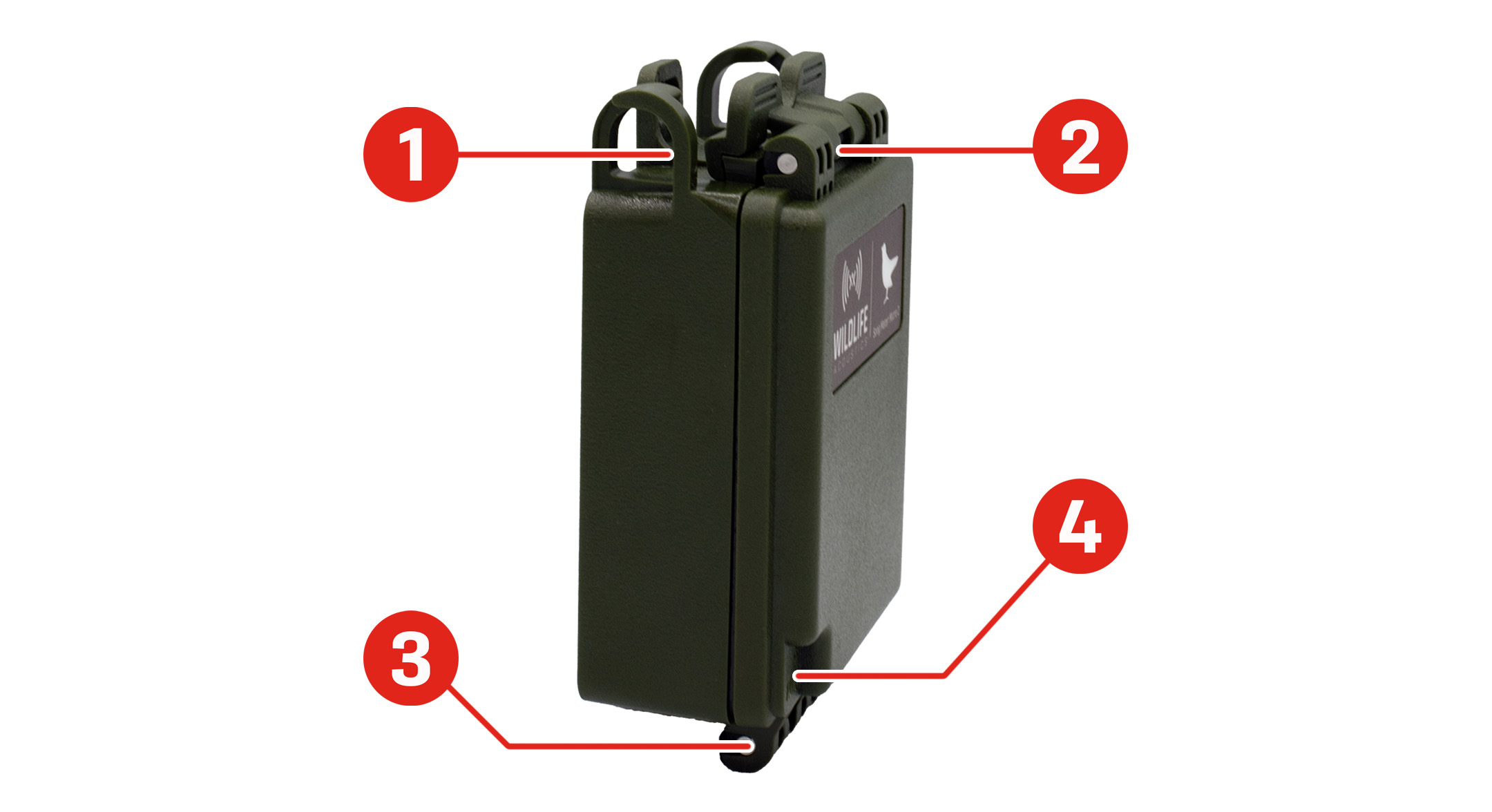
One of two Mounting Loops, which can accommodate bungee cords, rope, or cable locks up to a diameter of 0.420 in. (10.67 mm). See Versatile Mounting Options.
The Enclosure Latch snaps into place to keep the enclosure sealed.
The Enclosure Hinge keeps the lid and body of the recorder permanently attached.
One Acoustic Microphone is installed behind a vent on the front cover. It is protected by an internal, weatherproof membrane.
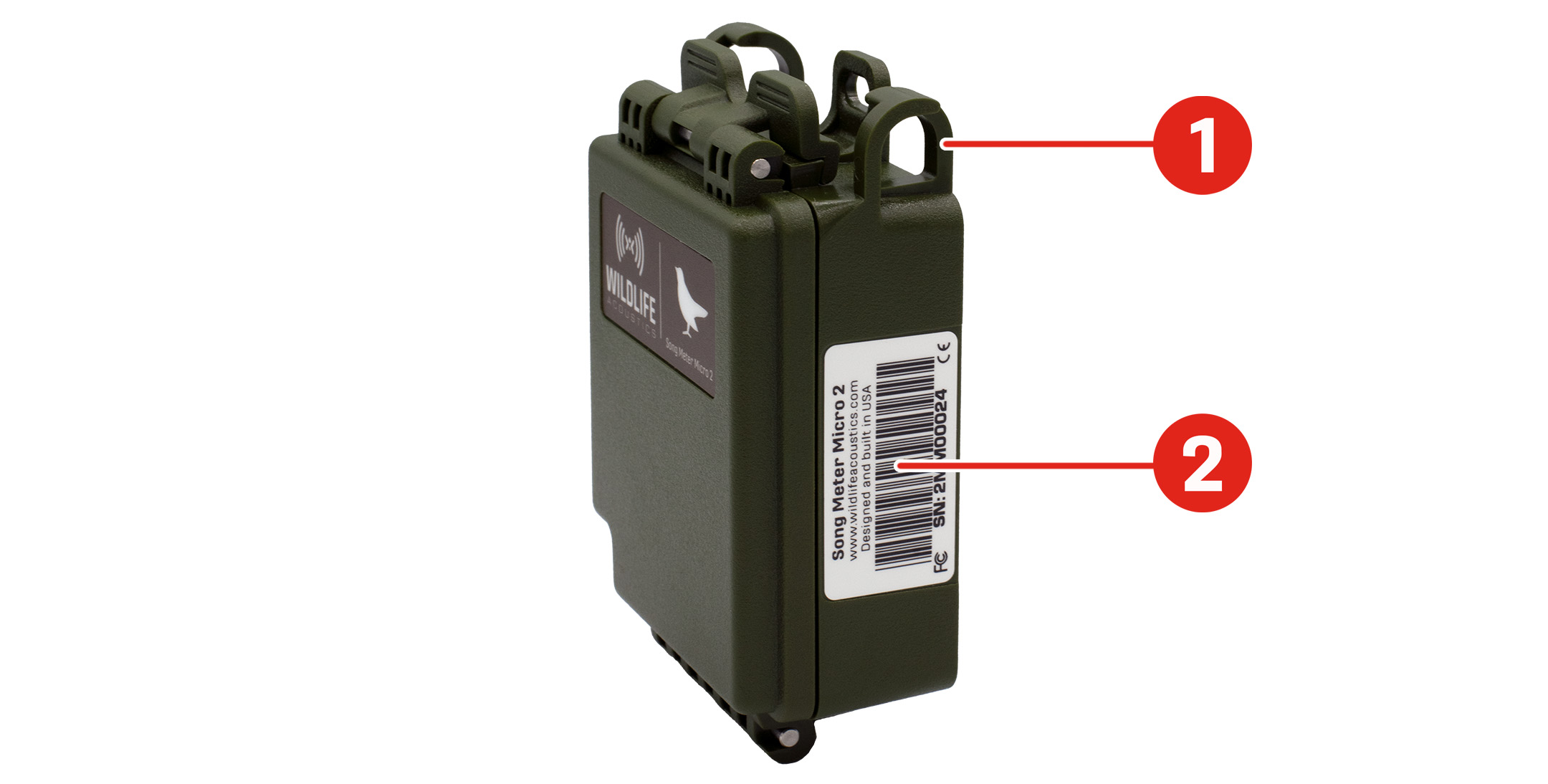 |
One of two Mounting Loops, which can accommodate bungee cords, rope, or cable locks up to a diameter of 0.420 in. (10.67 mm). See Versatile Mounting Options.
The Barcode Label lists the recorder's Model Name and Serial Number.
This information is also visible in the Song Meter Configurator app on the Status Screen.
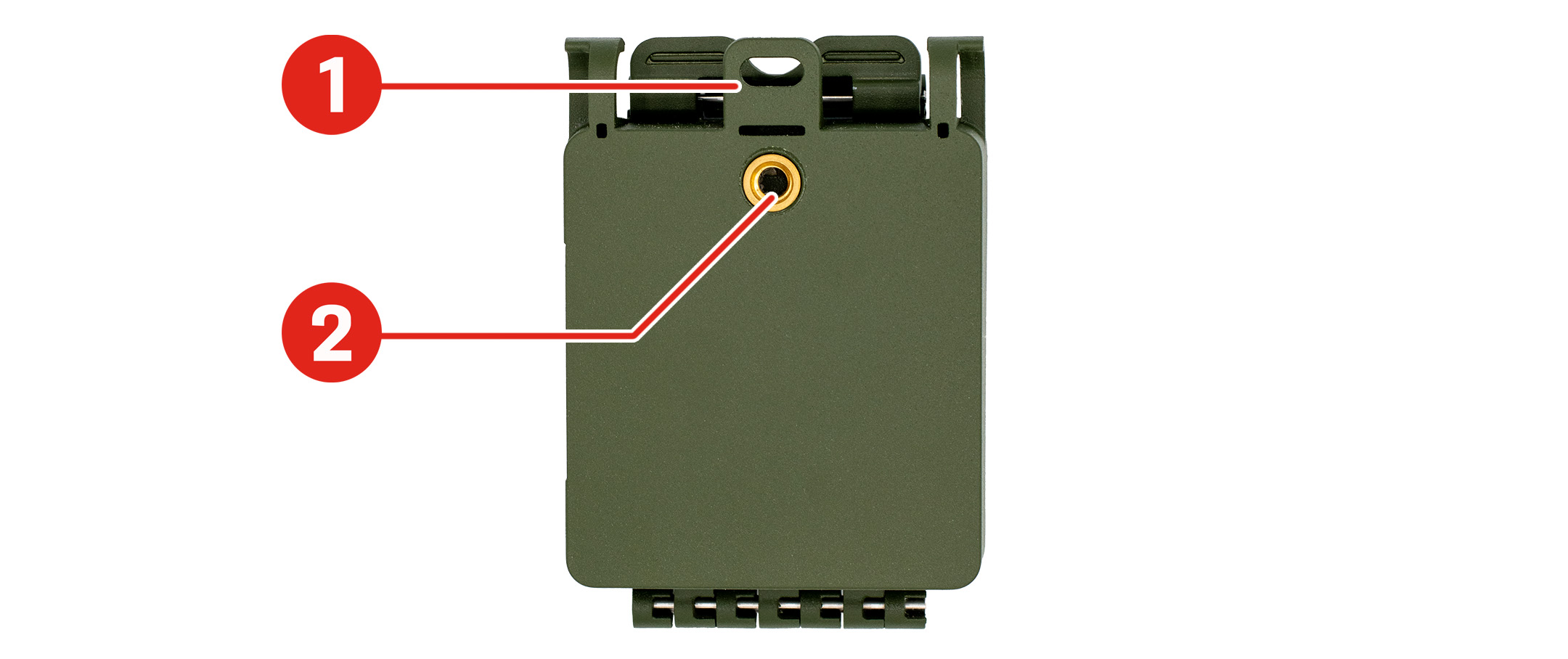 |
The Mounting Tab can accommodate bolts or screws with a maximum thread diameter of 3/16 in. (4.6 mm). It can also serve as attachment points for bungee cords or zip ties.
A Tripod Mount fits a 1/4ʺ-20 bolt, the same specification used by many cameras, including trail cameras.
The enclosure of the Song Meter Micro 2 is equipped with attachment points that support a wide range of mounting options:
The Mounting Tab at the top of the enclosure's back can accommodate bolts or screws up to 3/16 in. (4.6 mm) in diameter. It can also be used for attaching bungee cord hooks or zip ties, for example.
Mounting Loops at the upper-left and upper-right of the enclosure are suitable for cable locks, rope, zip ties, or bungee cords, among other possibilities. The internal diameter of these loops is 0.420 in. (10.67 mm).
The Tripod Mount on the back of the enclosure fits a 1/4ʺ-20 bolt, enabling compatibility with many mounting accessories designed for trail cameras.
Note
Be aware that not all camera mounts use the same bolt specification. For example, mounts designed for heavy video cameras may use a 3/8ʺ-16 bolt. Check the manufacturer's specifications when shopping for a compatible mount.
Important
With any mounting method, be careful not to apply excess force to the enclosure of the Song Meter Micro 2. If too much force is applied, the enclosure can flex, opening gaps between the lid and body and compromising the recorder's weatherproofing.
Take extra care when attaching the recorder to young trees. The tree's growth over the course of a deployment could increase the strain on the enclosure.
 |
A cable lock can be threaded through the two Mounting Loops along the top of the Song Meter Micro 2 to keep it attached to a tree or structure.
The diameter of a cable lock must be narrower than 0.420 in. (10.67 mm) to fit through the two Mounting Loops.
Internal Features
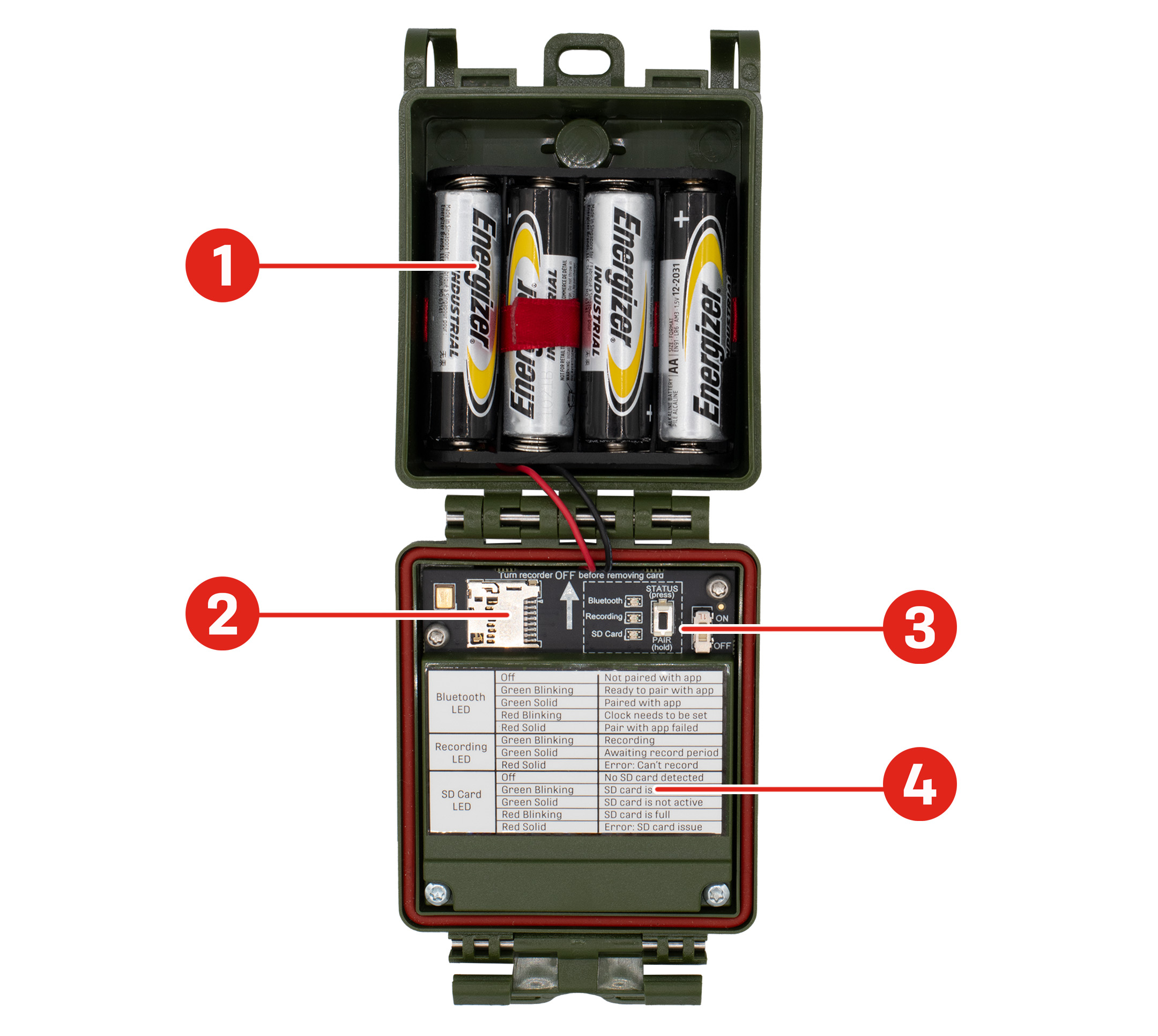 |
The AA Battery Compartment holds four AA batteries.
The microSD Card Slot holds a microSD card with a capacity up to 2 TB for storing recordings and other files.
The Control Panel is where you'll find several basic, physical controls. See Control Panel for a detailed image of this section.
The Status LED Key provides a guide for understanding the LEDs. This table can also be found under STATUS LEDs.
The AA battery compartment holds four AA batteries. All four batteries must be installed in order for the Song Meter Micro 2 to turn on.
The battery compartment has two ribbons fastened to the left and right edges of the compartment. Each ribbon should be positioned behind two batteries, with the free ends visible in between the middle two batteries. To easily remove the batteries, pull on the free ends of the ribbons.
For information on the different types of AA batteries, including Energizer® Ultimate LithiumTM, see Types of AA Batteries.
AA Battery Insertion Order
When inserting batteries, start near the attached end of each ribbon at the outer side of each tray and work towards the free end. This will ensure the ribbon has enough slack to make room for each battery. Without enough slack, the ribbon may push batteries out of the tray.
Best Practices for AA Batteries
Improper battery use can permanently damage your recorder. Always take care to follow these guidelines.
Do not mix new or freshly charged batteries with used or uncharged batteries. A single dead battery will prevent the entire set from functioning.
The recorder will lose power prematurely and may not power on at all.
Batteries may leak corrosive chemicals that can damage the recorder.
Do not mix multiple types of batteries (e.g. combining alkaline with NiMH). All four batteries must be of the same type.
Ideally, all batteries should be of the same brand and model. Mixing batteries with different characteristics can produce unpredictable results.
Ensure batteries are oriented correctly. The negative, flat end of the battery should contact the battery tray spring.
If one AA battery out of eight is inserted backwards, the Song Meter Micro 2 may power on, but a backwards battery will eventually leak corrosive chemicals that can damage the recorder.
Ensure batteries are oriented with the correct positive/negative polarity.
The Song Meter Micro 2 recorder saves recording files and a summary log to a microSD card installed in the memory card slot.
To insert a microSD card, slide it into the slot until it clicks into place. To remove, gently press the card further into the slot until it clicks again, and let the internal spring mechanism eject the card.
Only remove the SD card after setting the power switch to and waiting until all have turned off.
Use the Song Meter Configurator app to check recording space available on the SD card.
"SD Card" and "microSD Card"
Language in the Song Meter Configurator app and in this documentation may use the term "SD card" generically. This refers to both the full-size SD card used by the Song Meter Mini family and the microSD card used by the Song Meter Micro family.
The Song Meter Micro 2 only supports the use of microSD cards.
Recommended SD Card Brands
Wildlife Acoustics recommends the SanDisk® brand of SD cards for their superior performance. Kingston® and PNY® are also suitable.
Control Panel
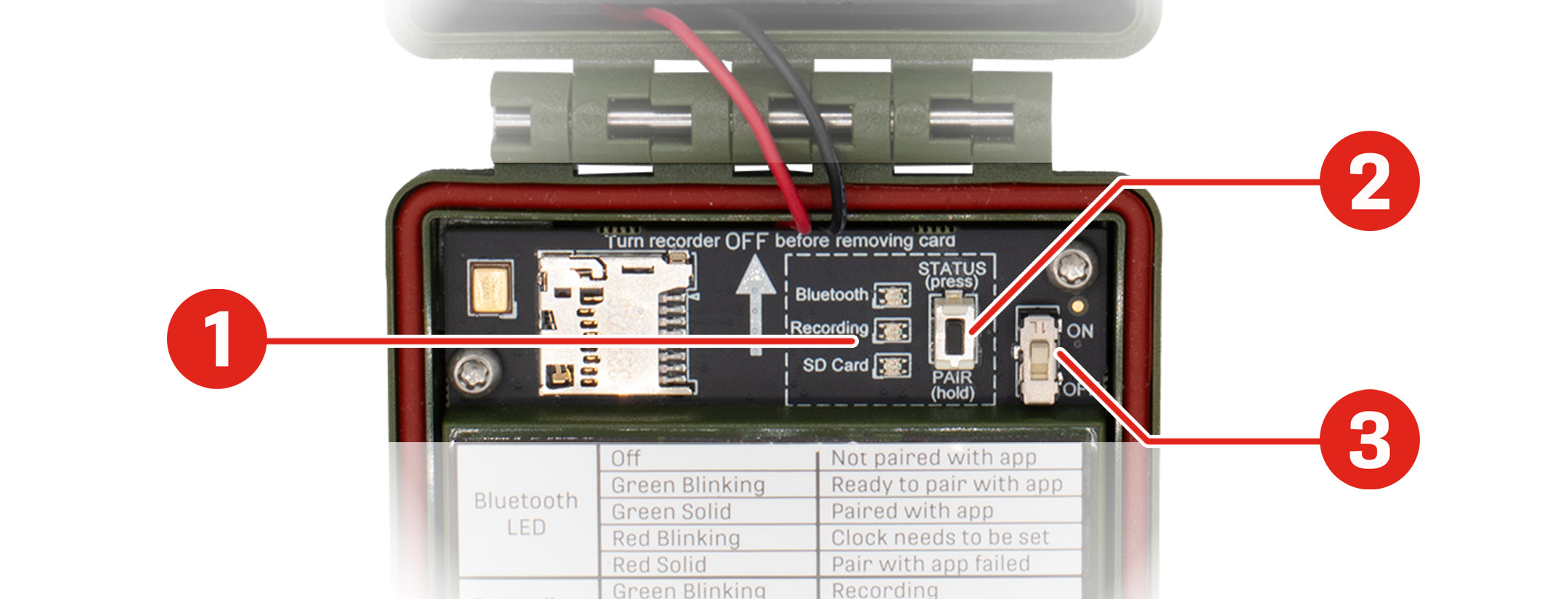 |
The button serves two functions:
Press and hold the button to initiate pairing with the Song Meter Configurator app. See Pair the Recorder with the Song Meter Configurator App.
Press the button briefly to activate the LEDs. See STATUS LEDs.
The LEDs provide visual feedback on the recorder's , , and status. See STATUS LEDs.
The switch powers the recorder on or sets it to a low-power, idle state. See ON/OFF Switch.
The three on the recorder provide , , and information.
The remain active while the recorder is paired with the Song Meter Configurator app.
The table of definitions, below, is also found inside the recorder’s lid for reference.
LED Label | LED Activity | Status Meaning |
|---|---|---|
| Off | Not paired with the Song Meter Configurator app |
Green Blinking | Ready to pair with the Song Meter Configurator app | |
Green Solid | Paired with the Song Meter Configurator app | |
Red Blinking | Clock needs to be set | |
Red Solid | Pairing failed | |
| Green Blinking | Recording |
Green Solid | Waiting for next recording period | |
Red Solid | Error: Cannot record | |
| Off | No SD card is detected |
Green Blinking | SD Card is active: do not eject | |
Green Solid | SD Card is inactive: safe to eject | |
Red Blinking | SD Card is full | |
Red Solid | Error: SD Card issue |
(up position): Full power is enabled. Schedule is started.
(down position): The recorder enters a low-power idle state. Schedule is stopped.
When the Song Meter Micro 2 recorder is first powered on, the LEDs show , , and status. If the recorder is unpaired and its buttons are not touched for one minute, the LEDs will turn off.
Note
When the Song Meter Micro 2 recorder is switched off, it goes through a routine to end and save any current recording. This can take a few seconds.
This process means it is safe to set the switch to at any time.
Microphone
The Song Meter Micro 2 utilizes a single, built-in microphone. The microphone is installed flush with the front face of the recorder. It is protected by a vent in the enclosure and an internal, weatherproof membrane.